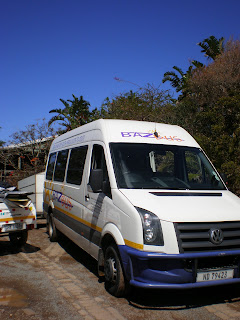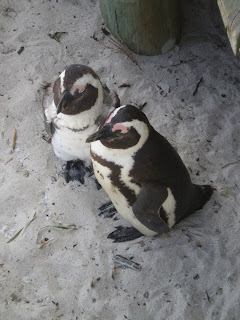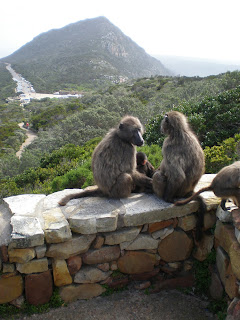Buffalo – These are the most dangerous of the Big 5. Usually people think the Lion or the leopard would be the most ferocious, however, it is due to the fact that buffalo are huge animals and have a lot of power to back up a powerful punch. Hunters usually have a very limited window of time to drop the animal. When attacked the buffalo, being so large, tend to be more aggressive. Instead of running away from the attacker they fight back. A charging buffalo is very similar to a speeding bulldozer. One hit and your done! The buffalo is a herbivore, meaning they eat plants and grass. They can weigh up to 1 or 2 tons and eat a vast quantity of food everyday to support their size. They are very similar to cows and used to be considered “King” of the animal kingdom, but I will get to that later.


Leopard – My friends and I decided these beautiful cats were the “ninjas” of the animal kingdom. They are swift and silent and extremely deadly. Leopards are solitary animals that are powerful but are small and can be easily over taken by the Lion. Once they have made a kill they often drag their meal up to 3 km away and then into a tree to enjoy. This eliminates other predators stealing their catch and can enjoy their dinner on their own time in a tree. The Garden Route Game Lodge has one leopard though he is not seen often because he can easily jump the fence and leave the reserve. They are the most cunning of the Big 5 and often avoid human contact. We unfortunately didn’t see him until later on our trip.
Lion – Popularly referred to as the “king” of the jungle and rightfully so, the lion is a formidable animal. However, I find that fewer people know how or why the lion was named “king”. Our guide on the game reserve told us the story passed onto him by the bushman or San people, the last hunter gathers on the planet.
Originally, the Buffalo was the king of the animal world. All other animals were subservient to him, including the Lion. One day the Buffalo wanted to host one of the biggest parties Africa has ever seen. He wanted everyone to attend and be merry and comfortable. A party of that size requires a lot of food and drink and so the Buffalo asked the Lion to go out and bring back enough food for everyone. The Lion was asked to bring back enough branches and grasses for the plant eaters and one of each animal for the meat eaters. The Lion being wise realized that bring back one of every animal included one of the Buffalo’s own. The Lion didn’t like to run around doing things for the King all the time. So he went and killed the King Buffalo and basically “killed two birds with on stone” by providing food for the party and effectively making himself King.


Rhinoceros – It seems true to grow to the size of their cage. When the cage is the size of sub-Saharan Africa, it means they all grow quite big! The rhino is now exception to this rule; they are HUGE! They spend most of their day eating, up to 700 kg of grass a day (1,543 lbs), just to support their shear size. The park just recently had a population increase in their rhino population. They have a nine-month old baby rhino named “Hibabi” which in Arabic means ‘loved one’. The last three or four months of pregnancy of rhinos is done in alone. When she returns to her mate, the male rhino often tries to kill his own young. This is because he doesn’t recognize his child as his and doesn’t want another male’s youngster being raised by him and his mate. The female rhino is equally strong and can usually fight back and save the child, which then the male rhino accepts as his own. The female will spend the next several years with her youngster until it is fully weaned and grown.


Elephant – Elephants are the largest of the Big 5. The ones on the reserve were a coupled pair. They park has specialized workers who work with the elephants. They are very smart creatures and it’s true they and an incredible memory. They really never forget. The elephants in the park are kept as wild as possible and are allowed to do what they want and roam around. The trainers are there for safety, which was apparent when the female elephant came up to us in the truck and checked us out. We were told she was looking for a snack that some trainers bring with them, such as an apple or orange and thought she might be able to get something out of us.


Cheetah – They are the fastest land animals on the planet. They can run up to 80 kph (~50 mph) for about 3-5 km (~2-3 miles) at a time. However, they tire out easily and are not as great at catching prey as the leopard. According to the San people, the Leopard and Cheetah were once brothers. They hunted together, rested together and were together all the time. Soon, the two realized they could have twice the amount of food if they hunted separately. So they split up, and each night they would split whatever they caught for the day. The Leopard was a much better hunter than the Cheetah. He was constantly coming back with dinner and rarely did the Cheetah produce anything. The Leopard wondered why he was doing all the work and his brother reaped all the benefits. So the Leopard got smart and stopped splitting his dinner with his brother. Instead, he would take it up into a tree and eat there where his brother, the Cheetah, couldn’t follow him. This produced a deep rift between the two brothers and a deep sadness. The dust from the savannah was swept into the Cheetah’s crying eyes. This is why they have the tear drop eye markings. They split ways and that is why you don’t see leopards and cheetahs together in the wild.


Zebra – The zebra is a beautiful creature. The question remains: are they black with white stripes? Or are they white with black stripes? And how did they get these stripes? The San people believed that when the gods created the animals he made them all white. The Lion, the “king” of all the animals, saw this as a problem. He couldn’t keep track of his subjects and tell them apart. So he asked the gods to provide cloth to the animals so he could tell them apart. The gods, in their ultimate wisdom, told the Lion that they would give him the clothes he needed to make clothes for the animals so he could tell them apart. The Lion, took the clothes, and instead of make the clothes himself, he called a meeting with the animals. They were all to come and pick out their cloth and make clothes for themselves. The Zebra, however, loves to eat. He eats all day and was oblivious to the appointment set by the Lion. So they missed it, and as the day grew long the Zebra began to see animals coming back from the meeting. They were dressed in the most amazing of cloths fashion into fabulous coats. The Zebra immediately went to the Lion, who was cleaning up the rest of the cloths to give back to the gods. Seeing that the Zebra hadn’t chosen a cloth to make clothes out of he handed the Zebra a black cloth of poor quality. When the Zebra fashioned his coat, it tore in different places. Over time the cloth wore down into stripes and that is how they got their magnificent stripes.


The San, who had never actually shaved the zebra, never knew their true color. The only way you can decide on color of an animal is look at its skin. This is often covered by thick fur or hair. Physiologically, the zebra is a black skinned animal. This means, that the zebra is actually black with white stripes. However, don’t let that minor detail distract from the San people’s story.
Interesting stuff, huh?


















































